Buying Advice: Setting High Standards
Words by Terry Owen
Your guide to build standards, and energy efficiency and regulations ... All you need to know before buying a holiday home, lodge or residential park home.
It may surprise you to learn that residential park and holiday homes are not covered by building regulations, not even those used as a permanent residence. However, two important standards do apply and here we look what they provide.
It's a simple matter of fact that building regulations are not best suited to products that are constructed differently from conventional bricks-and-mortar dwellings and which remain, in theory, permanently mobile. Residential park and holiday homes were once thin-walled, single-glazed units with poor insulation and high heating costs.
As long ago as 1963, it was apparent that building regulations were of little use for park homes and that some form of standard was needed for those used for year-round residential purposes. Accordingly, BS 3632 was introduced to protect the safety and health of occupiers.
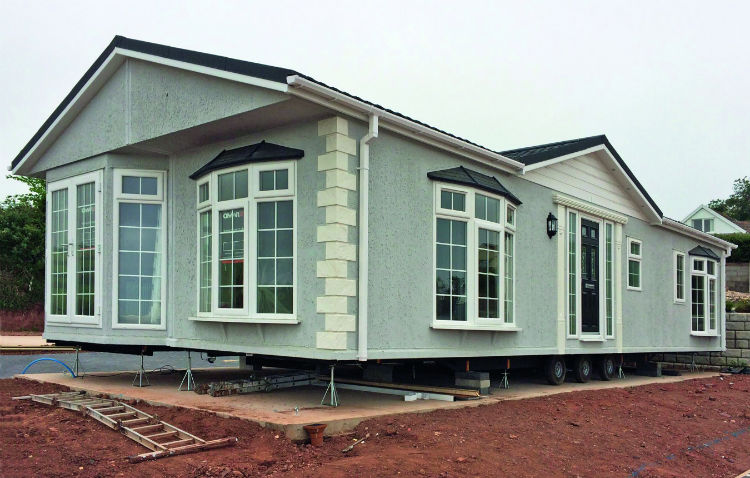
Above: A well supported chassis is essential for the long life of any residential park home. This luxury twin unit from Omar sits on multiple stands atop a concrete foundation slab.
Since then, the standard has been revised no less than six times to account for changes in technology and the need for better insulation in much in the same way as house building regulations approved documents have been revised several times for these reasons.
Buying Your First Holiday Home - 2023 special edition
Find out everything you need to know about buying your first holiday home, or choosing your next one, with the new edition of Buying Your First Holiday Home.
Rising Energy Costs
By 1999, rising energy costs also led to a standard introduced for holiday homes. Here we look at both standards and what they mean to prospective purchasers. We also look at the National Caravan Council's (NCC) energy efficiency rating schemes which give you a good idea of how one holiday home performs against another, and how residential park homes perform.
The BS3632 standard covers all residential park homes, and often covers products referred to as lodges. ('Lodge' is actually a marketing term usually used to denote a style – for example, clad in wood, and open-plan in layout. 'Lodge' can therefore also be used for a caravan holiday home in that style).
By definition, residential park homes are intended for year-round occupation. BS 3632 defines the minimum specifications for many items, including ventilation, thermal and acoustic insulation, vapour control, extraction, structural stability, and so on. It even covers stability during transportation.
Also, covered are areas like electrical services and heating installations (both solid fuel and alternative energy sources), water supply, drainage, fire-escape routes, doors, windows, cooking appliances and even handbooks. The idea is to ensure the homes are safe and sensible to use for their intended purpose. The current version of BS 3632 is dated November 2015 and takes into account increases in required energy efficiency as well as improvements in technology.
The bottom line is that today's residential park homes are better built and better insulated than ever before. Consequently, they can cost less to run and are more comfortable to live in. It also means they could last longer, with a lifespan of 30, 40 or even 60 years, when properly maintained.
What about Holiday Homes?
Holiday homes are by definition designed to be occupied for part of the year; many parks have a closure period in the coldest months of the winter. This means they do not need the same standards of insulation as residential park homes. (In practice, though, many holiday homes are built to residential standards, respecting the fact that some parks are open all year.)
Holiday homes are covered by a different standard - BS EN 1647. First published in 1999, the standard has since been updated three times to account for changes in technology and increasing energy prices.
The current version of the standard dates from 2012. It covers fewer areas than BS 3632 and, as you might expect, the requirements are less stringent. This is because it's important for holiday homes to be as affordable as possible and that means tailoring the build specification accordingly.
For example, levels of insulation, both thermal and acoustic need, in theory, only be sufficient for holiday requirements during the warmer months.
Of course there's nothing to stop a manufacturer building holiday or residential park homes to higher specifications than are laid down in the standards and indeed many do. For example, all Pemberton's products come with 250mm roof insulation – more than is needed to meet either standard. Another example is Tingdene, which builds all its holiday lodges to BS 3632.
Where high levels of insulation are not standard, it is sometimes possible to pay extra for an upgrade that will boost the thermal performance. ABI and Atlas, for instance, allow buyers to upgrade some of their holiday homes to residential park home standard when they place the order.
Carnaby stays with BS EN 1647 but offers an Ultra Warm Plus pack that takes the structural thermal rating up to 9.1 out of 10 on some of its caravan holiday homes.
The following table illustrates a typical thermal comparison between the two standards. The insulation material is based on glass wool. Other materials may result in different thicknesses being used. What matters is the thermal performance.
Swift, for example, meets the EN 1647 standard using a bonded wall construction borrowed from touring caravan and motorhome production. This combines good strength with good insulation.
Ensuring Compliance
Compliance with these standards is monitored by the NCC (National Caravan Council). They work with many partners including BSI, European Standards organisations, the Health & Safety Executive, Gas Safe and Fire Inspectorate to ensure the industry's products comply and are safe.
The NCC Product Approval teams examine a whole raft of factors to ensure the relevant standards are met. Every manufacturer (in the case of residential park homes) or manufacturer's model (in the case of holiday homes) approved is licensed to display an NCC Approved Badge and each home has an NCC approval certificate.
The team also assess the energy efficiency of each model and awards a rating accordingly.
NCC Energy Efficiency Rating Schemes
If you're in the market for a residential park home or holiday home, it's useful to know how one model compares with another from an energy efficiency view. To help you, the NCC has produced two thermal rating schemes, one for residential park homes and the other for holiday homes.
NCC Residential Park Home Energy Efficiency Rating Scheme
The scheme takes into consideration the insulation qualities of the fabric of the home and the amount of energy required to heat the air passing through it. Also, included are the efficiency of the central heating and water heating equipment and the energy consumed by the fixed lighting.
Using typical weather data, the calculator generates a rating label that gives an indication of the total energy consumption across 12 months of residential occupancy. In common with other energy efficiency rating scales, the most efficient homes are those with a rating at the green end of the scale whilst the least efficient have a rating in the red zone.
The ratings are based on the calculated energy consumption per square metre of floor area. An estimate of the carbon dioxide emissions per square metre of floor area is also provided.
| Minimum Insulation Thickness | ||
|---|---|---|
| BS EN 1647 | BS 3632 | |
| Doors | 37mm averaged, across all, components | 26 mm |
| Windows | 28 mm | |
| Walls | 126 mm | |
| Floor | 126 mm | |
| Roof | 220 mm | |
Homes with features like gas central heating are likely to have a higher rating than equivalent electrically heated ones because of the additional losses incurred by centrally generated and distributed electricity.
NCC Holiday Home Thermal Rating Scheme
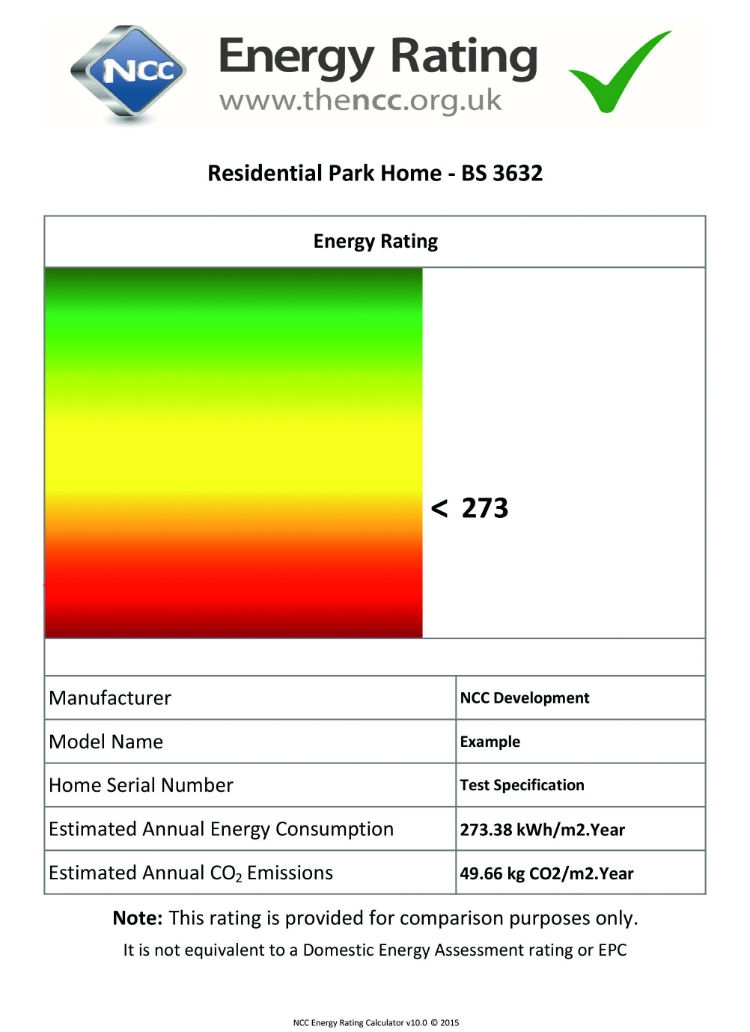 The scheme is like that for residential park homes but simply looks at the likely heat losses that will be incurred through the fabric of the home. In doing so, it assumes the home isn't used during the coldest part of the year, i.e. from the beginning of December until the end of February.
The scheme is like that for residential park homes but simply looks at the likely heat losses that will be incurred through the fabric of the home. In doing so, it assumes the home isn't used during the coldest part of the year, i.e. from the beginning of December until the end of February.
The rating is based on the calculated seasonal heating load per square metre of floor area. A score of between 1 and 10 is awarded to each home based upon its thermal rating. The higher the number, the better from an insulation view.
To distinguish the rating from that for residential park homes built to BS3632, the scheme uses a horseshoe-shape to depict the result. This makes it easy to tell at a glance to which standard a home has been built.
Thermal rating labels for both schemes should be prominently displayed in the front windows of each home at shows and showgrounds until the home is sold. A copy of the rating label should also be included in the home's information pack along with the NCC scheme approval certificate.
Size matters!
Beware that, under these schemes, homes with large floor areas score more highly than those of identical construction with smaller footprints. This is because they have proportionally less wall area (to lose heat) per square metre of floor space. Care should therefore be taken to only directly compare homes of similar sizes.
Climate chamber testing
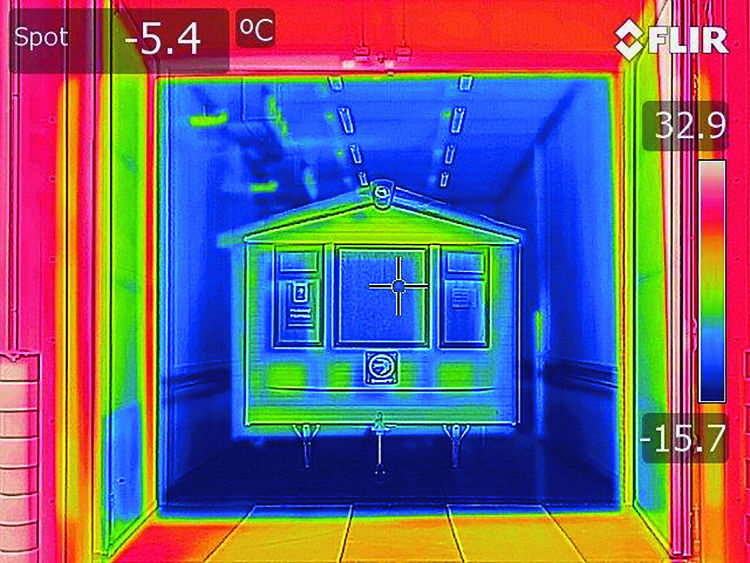
Today it's commonplace to subject touring caravans and motorhomes to full climate chamber testing. Park and holiday homes, however, are a different kettle of fish, not least because of their sheer size.
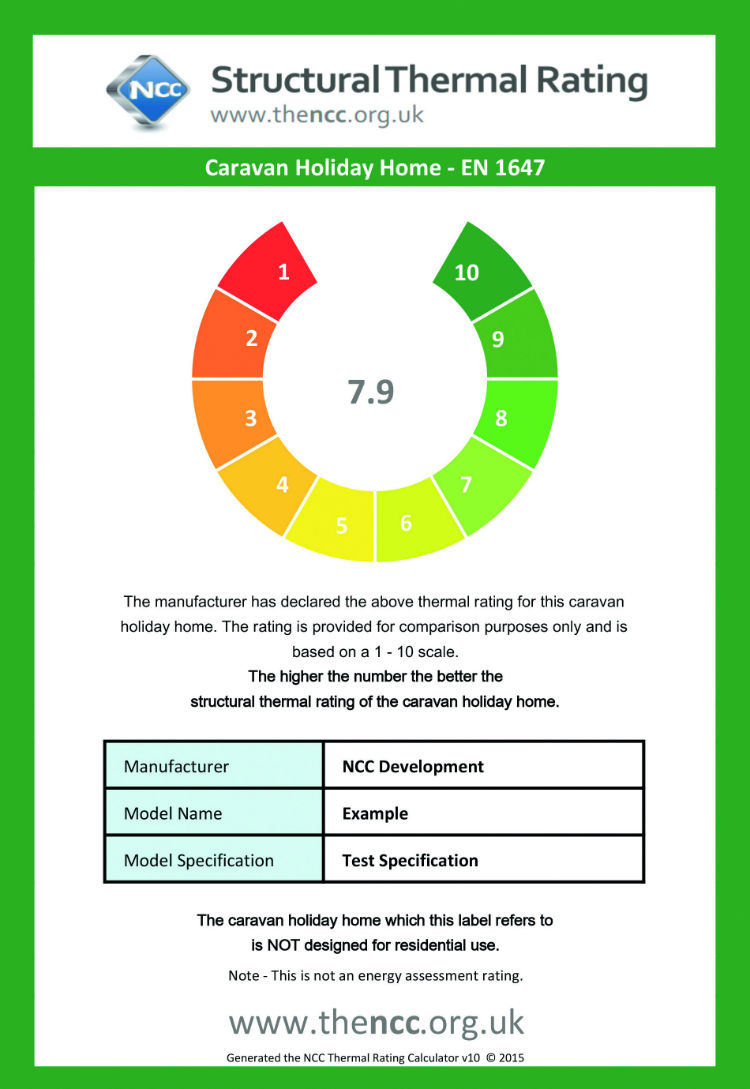 As implied, the energy ratings of the NCC's schemes are arrived by calculation and there's nothing wrong with that. Swift, however, goes a step further by testing its holiday homes in an environmental chamber. This helps them to optimise the heating and ventilation as well as to measure the thermal performance.
As implied, the energy ratings of the NCC's schemes are arrived by calculation and there's nothing wrong with that. Swift, however, goes a step further by testing its holiday homes in an environmental chamber. This helps them to optimise the heating and ventilation as well as to measure the thermal performance.
Conclusion
Residential park and caravan holiday homes have come a long way from their humble beginnings in the 1960s. Today's units provide all the comforts of a modern home. The two British standards, combined with the NCC's energy efficiency rating schemes, enable you to buy with confidence that the product will perform well for its intended use.
Buying Your First Holiday Home
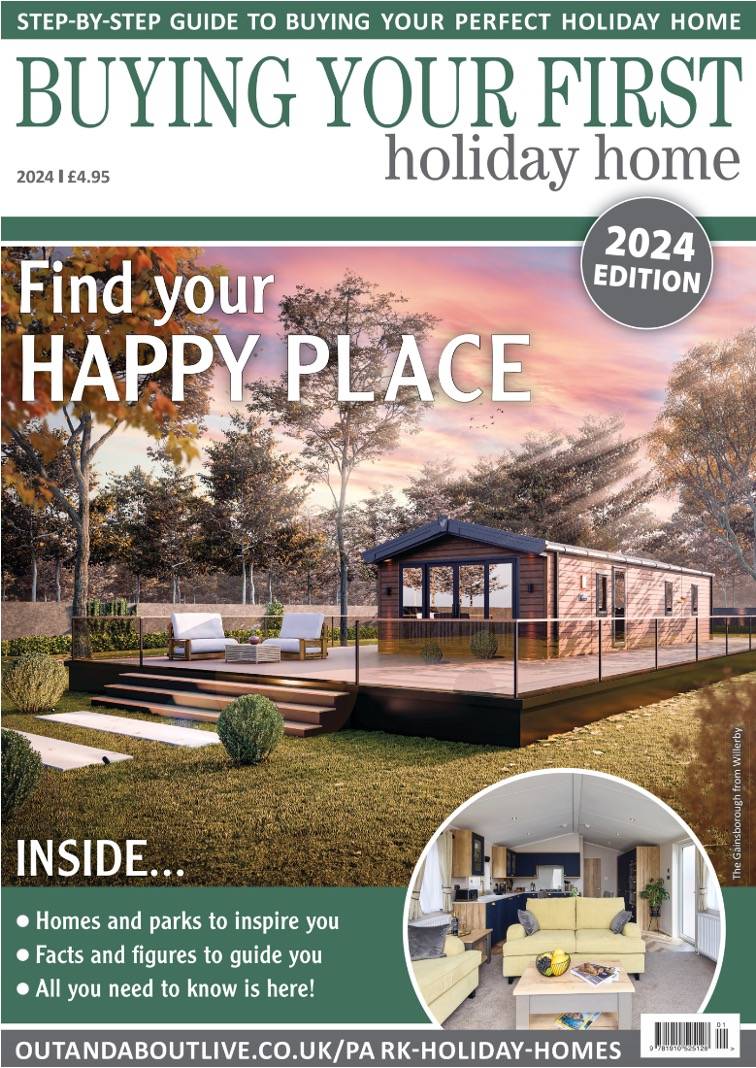
The guide is packed with expert advice and information to help readers buy the right holiday home for them. It provides details on the latest holiday homes and lodges from leading manufacturers including Willerby, Omar, Regal, Tingdene, Pemberton and Victory. It also includes a section on parks, to guide holiday home buyers on the best choice of park to suit them.
Instant access is available through our digital partner, Pocketmags.
Find out moreAbout Park & Holiday Home Inspiration magazine
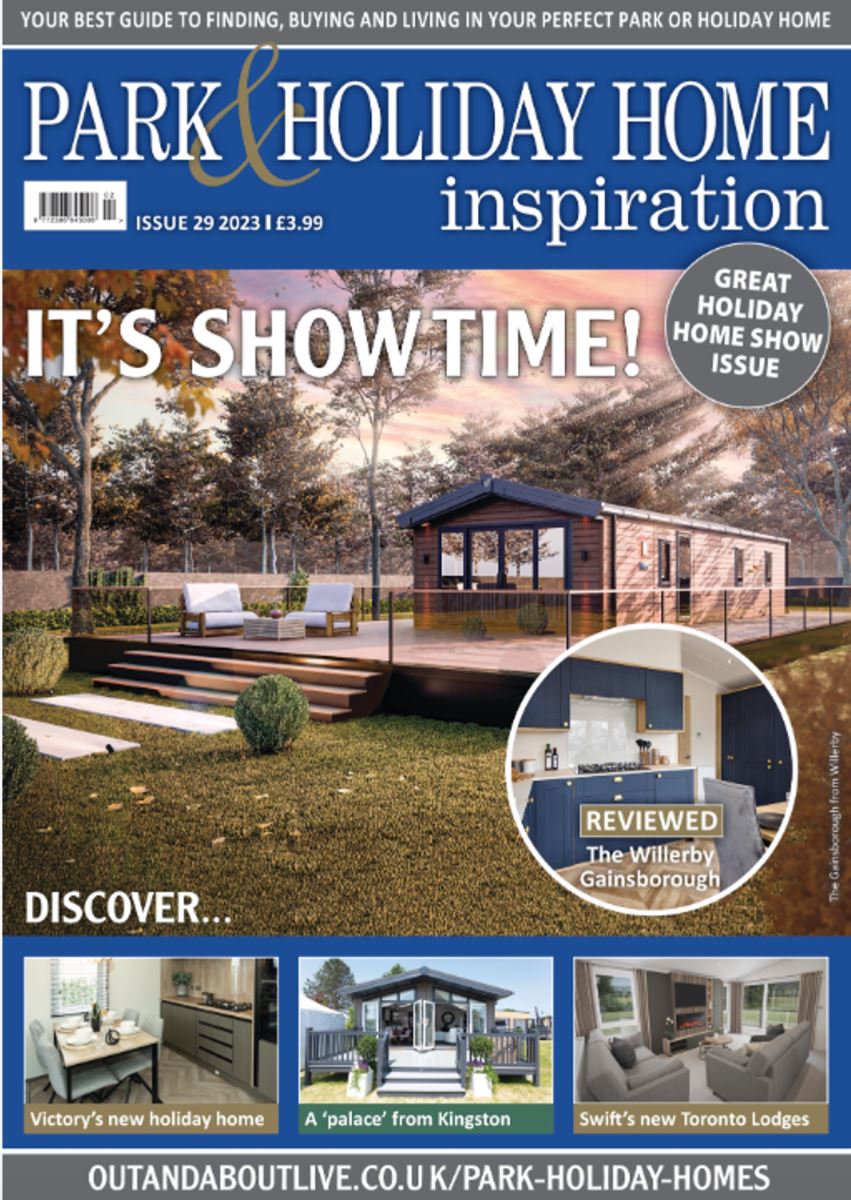
Park & Holiday Home Inspiration magazine is the best guide to finding, buying and living in your perfect park or holiday home. The magazine is ideal for both the budding buyers to be, or for those who have been living the life of luxury for years.
Want to know more?
Park & Holiday Home Inspiration







Recent Updates
Park home surveys: all you need to know
For buyers of pre-owned park homes, a survey is vital to make sure the property you're buying is structurally sound and has been properly valued - ...
Selling a park home: all you need to know
Selling your park home is rarely an easy decision, so make the process easier with our guide to managing the ...
Park home energy: all you need to know
Make your park home more energy efficient with these tips, helping to save you money and be more ...
Park home refurbishment: all you need to know
Maintaining the condition of your park home, from its bathroom fittings to the condition of its chassis, is ...
Living in a park home: all you need to know
What's it really like to live in a park home? What are the pros and cons, the fees involved and the most ...
Forest retreats: all you need to know
Relax and immerse yourself in nature with a holiday home forest retreat, fusing the community and perks of a ...
Our guide to holiday homes by the sea
If you're interested in buying a holiday home, chances are you're going to look at a coastal holiday park – ...
Holiday homes for all budgets: our guide to mid-level holiday homes
If you are looking for a quality holiday home but don’t want to buy at the top end, the good news is that you ...
Holiday homes for all budgets: our guide to affordable holiday homes
Buying a holiday home on a budget may initially seem a daunting prospect – but there is a lot of choice out ...
Park and holiday home decking: everything you need to know
Decking is a fantastic addition to your holiday home, helping you to enjoy a more outdoorsy lifestyle ...
Other Articles
Park and holiday home finance: everything you need to know
Looking to buy a park or holiday home on finance? While holiday home mortgages are off the table, you can find great finance deals on park and ...
Park home part exchange: what you need to know
Our essential guide for anyone thinking of buying a residential park home using part exchange, including ...
Solar panels for park homes: our advice
If you're considering installing solar panels on your park home, you're far from alone – this growing trend ...
Buying a park home: 10 things to consider
Buying a home on a residential park is a huge and exciting step. Here is our comprehensive guide to making ...
Park home and holiday home chassis: everything you need to know
The chassis underpins the structural integrity of a park home or holiday home. This guide to the essentials ...
Holiday home and park home insurance: your complete guide
Specialist insurance is key to finding the cover most suitable for both park and holiday homes. Read our ...
Park home maintenance advice
Your park home chassis, roof and guttering need to be kept in top condition and older homes may benefit from ...
Park home construction: everything you need to know
A complete guide to park homes, including how and what they are made of ...
Park home paint: how to keep your park home in pristine condition
Our guide to painting your park home and keeping it looking its best ...
A top choice of holiday homes for sale
For your perfect home away from home, take a look at this great selection ...